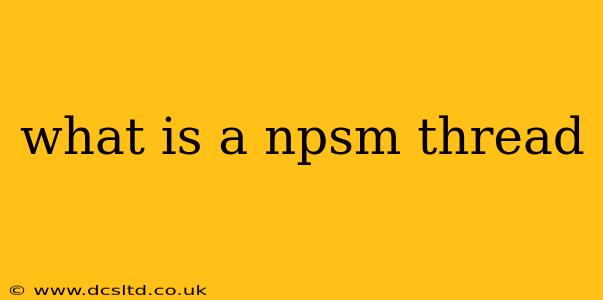What is an NPSM Thread?
NPSM (National Pipe Straight Mechanical) threads are a type of pipe thread commonly used in the United States and other countries. Unlike NPT (National Pipe Taper) threads, which have a tapered profile, NPSM threads are parallel, meaning their diameter remains constant along their length. This key difference significantly impacts how they function and are applied.
Understanding NPSM threads requires looking at their defining characteristics and comparing them to their more widely known counterpart, NPT threads. Let's delve deeper into the specifics.
What are the key differences between NPSM and NPT threads?
This is a crucial question for anyone working with pipe fittings and threads. The core distinction lies in the taper versus parallel nature of the threads:
-
NPT (National Pipe Taper): These threads have a slight taper, meaning the diameter decreases along the length of the thread. This taper creates a seal when the threads are tightened, relying on compression to create a leak-proof joint. The sealant is often PTFE tape or pipe dope.
-
NPSM (National Pipe Straight Mechanical): These threads are parallel, meaning the diameter remains consistent along the thread length. They require a precisely machined joint and often rely on a separate gasket or sealing mechanism for a leak-proof connection. They are not designed to seal via compression alone.
This difference dictates their application: NPT threads are often preferred for situations requiring a self-sealing joint, while NPSM threads are favored where a more precise, easily-disassembled connection is needed.
What are some common applications of NPSM threads?
NPSM threads are less prevalent than NPT but find application in specific scenarios where their parallel nature offers advantages:
-
Applications requiring easy disassembly: Since NPSM threads don't rely on compression for sealing, they are easier to disassemble and reassemble multiple times without damaging the threads. This is beneficial in situations where frequent access or maintenance is required.
-
High-pressure applications (with proper sealing): With a well-designed gasket or seal, NPSM threads can handle high pressure effectively. The parallel nature ensures a consistent, strong connection.
-
Applications where precise machining is crucial: The parallel nature of NPSM threads allows for tighter tolerances and more precise control over the connection.
What are the advantages of using NPSM threads?
Several key advantages make NPSM threads suitable for particular applications:
-
Reusability: The parallel threads make repeated assembly and disassembly easier without compromising the integrity of the connection.
-
Precision: NPSM threads are typically more precisely machined than NPT threads, leading to a more consistent and reliable seal (with a proper gasket).
-
Higher strength in certain applications: When properly sealed, NPSM connections can offer comparable or even superior strength to NPT threads in certain high-pressure situations.
What are the disadvantages of using NPSM threads?
Despite their advantages, NPSM threads also have some drawbacks:
-
Requirement for a separate sealing mechanism: Unlike NPT, NPSM connections necessitate a separate gasket or sealant to ensure a leak-proof joint. This adds complexity and cost.
-
Less common than NPT: The lower prevalence of NPSM threads can make sourcing parts and finding experienced technicians more challenging.
How do I identify an NPSM thread?
Identifying NPSM threads usually involves looking for the marking "NPSM" on the pipe or fitting. The threads themselves will appear parallel, unlike the tapered threads of NPT. Always check the markings to avoid confusion and ensure proper compatibility.
In conclusion, NPSM threads represent a valuable alternative to NPT threads in situations demanding easy disassembly, precise machining, or where a well-engineered gasket can compensate for the absence of a self-sealing mechanism. Choosing between NPT and NPSM depends entirely on the specific application and its requirements. Understanding their differences is vital for making informed decisions in mechanical engineering and plumbing applications.
